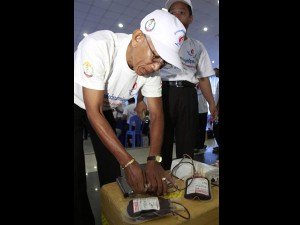Diabetics get blood vessels made from donor cells

Cambodian medical officers collect bags of blood after students donated their blood at a World Blood Donor Day campaign in Phnom Penh, Cambodia (AP Photo).
MILWAUKEE — Three dialysis patients have received the world’s first blood vessels grown in a lab from donated skin cells. It’s a key step toward creating a supply of ready-to-use arteries and veins that could be used to treat diabetics, soldiers with damaged limbs, people having heart bypass surgery and others.
The goal is to one day have a refrigerated inventory of these in various sizes and shapes that surgeons could order up as needed like bandages and other medical supplies.
The work so far is still early-stage. Three patients in Poland have received the new vessels, which are working well two to eight months later. But doctors are excited because this builds on earlier success in about a dozen patients given blood vessels grown in the lab from their own skin — a process too long and expensive to be practical.
“This version, built from a master donor, is available off the shelf and at a dramatically reduced cost,” estimated at $6,000 to $10,000, said Todd McAllister, chief of Cytograft Tissue Engineering Inc., the San Francisco-area company leading the work.
The American Heart Association considers it so promising that the group featured it on Monday in the first of a new series of webcasts about cutting-edge science.
“This is tremendously exciting,” because the failure of blood vessels used in dialysis is “a huge public health problem,” said Duke University’s Dr. Robert Harrington, a heart expert who had no role in the work.
If a larger study getting under way now in Europe and South America shows success, “this is big news,” Harrington said.
Kidney failure, which is common in diabetics, requires dialysis to filter wastes from the blood through a connection between an artery and a vein called a shunt. It gets punctured several times a week to hook patients up to the dialysis machine, and complications include blood clots, clogging and infection.
What’s more, patients often run out of suitable sites for these shunts as problems develop. Plastic versions have high rates of failure and complications, too. Doctors have long wished for a natural substitute.
The lab-grown vessels are free of artificial materials. They don’t involve stem cells, so they’re not controversial.
Researchers start with a snip of skin from the back of a hand, remove cells and grow them into sheets of tissue that are rolled up like straws to form blood vessels.
So far, these lab-grown vessels have been tolerated by the recipients’ immune systems; no anti-rejection medicine or tissue matching is needed. That’s not surprising because lab-grown skin is already used to treat many burn victims.
“There are literally hundreds of thousands of patients that could use this technology,” McAllister said.
Each year, nearly 400,000 Americans undergo dialysis and half of them use plastic shunts. More than 160,000 people lose limbs because of poor circulation that might be improved with lab-grown vessels.
About 300,000 people have heart bypass operations using blood vessels taken from other parts of the body to create detours around clogged heart arteries. Some heart patients say the leg wound from removing the long vein to create heart bypasses hurts more than the chest wound for the open-heart surgery.
In 2005, Cytograft reported success with its first attempt at dialysis shunts using patients’ own skin. Some of the early work was sponsored by the National Heart, Lung and Blood Institute.
The new work, using donor cells, makes this advance more practical for wide use, said Dr. Timothy Gardner, a heart surgeon at Christiana Care Health Services in Newark, Delaware, and former American Heart Association president.
“It provides the option or the opportunity for off-the-shelf graft availability as opposed to something that has to be built from the individual’s own cells,” he said.
Cytograft plans a study in Europe and South America comparing 40 patients getting the lab-grown vessels to 20 getting plastic shunts. Studies also are planned on a mesh version for people with poor leg circulation.